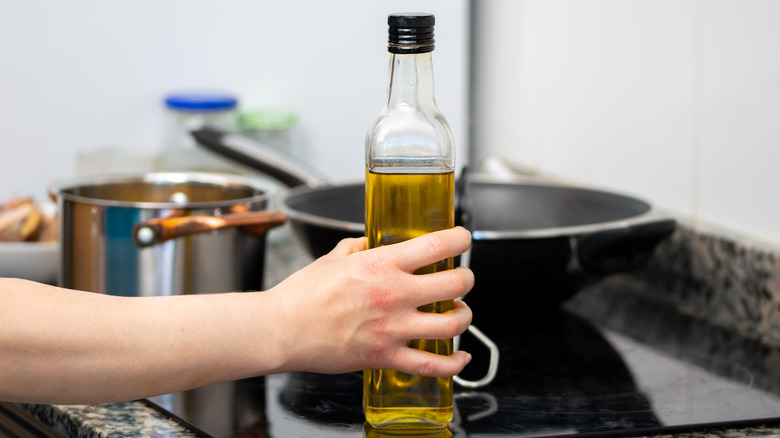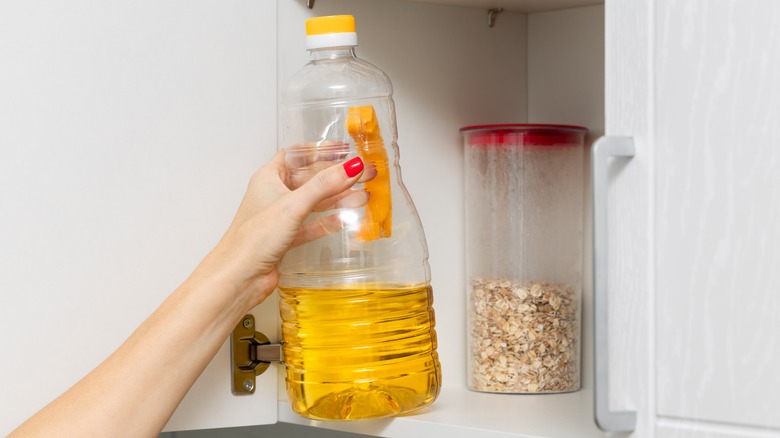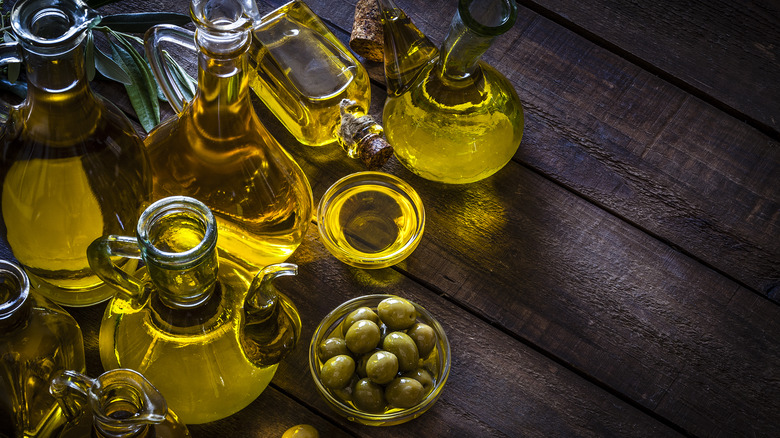Why You Should Never Store Olive Oil Near The Stove
There are certain ingredients that cooks like to keep nearby at all times. Salt, pepper, and cooking oil are a few items you probably keep right next to your stove, so you can grab them the moment you need them. However, if your cooking oil of choice is olive oil, you'll want to grab your bottle and move it away from the stove ASAP.
With its high smoke point, fresh flavor, and plethora of health benefits, olive oil is a great choice for frying and sautéing, as well as dressings, sauces, and as a finishing drizzle on countless dishes. A bottle also lasts for a while, but only if you store it properly. Any oil can go rancid if you don't treat it right, and one of the biggest mistakes you can make with olive oil is storing it near the stove, especially if you like to enjoy it as a garnish, dipping oil, or in any other "raw" application.
Olive oil's biggest enemies include sunlight, air exposure, and heat. Even if you seal your bottle tightly and minimize light exposure, keeping it near the stove is a huge "no." The oil will absorb atmospheric heat every time you use the stove, then slowly cool down. These temperature fluctuations will turn it rancid quickly, spoiling its flavor. There are a few ways to tell if your olive oil has spoiled, but it's even more helpful to learn about better places to store it.
The best place to store your olive oil
Many sources advise that the best place to store your olive oil is in a cool, dry place, like in the back of your pantry. Some experts take it a step further and say that putting the oil in the refrigerator after opening it is the best option. The oil will turn cloudy and solidify when it's cold, so you'll have to thaw it before using it as a dipping oil or garnish, but the fridge can be worth it if your kitchen is consistently warm or hot.
Once your bottle of olive oil is opened, it will retain its best quality for three to six months if kept in a cool, dry, and dark location. If you're using it regularly, you'll likely finish the bottle well within that window, if not sooner. But if it takes you a long time to go through a bottle, consider putting a smaller bottle of oil away in your pantry for everyday use, while storing the rest of it in your fridge. Replenish your smaller, on-hand bottle as necessary.
Additionally, if you have a very high-quality, first cold pressed, extra virgin olive oil — one that you use sparingly for drizzling — it's a great idea to store it in the refrigerator to maximize its shelf life. Again, you'll have to defrost it, but you definitely don't want to have to throw out a more expensive oil.
How do you know olive oil has gone rancid?
Now you know the proper way to store olive oil, but if you've kept your current bottle by the stove for a while, now, you may wonder about its quality. Luckily, it's pretty simple to tell when olive oil is no longer fit for consumption. The first sign is that the smell will be off and unpleasant. Fresh olive oil smells like olives — fruity, fresh, and what some might describe as "green" or grassy. Rancid oil might smell strongly, akin to the smell of glue, crayons or even peanuts. It won't taste right, either. If you sample a bit of the oil and detect a sour or very bitter flavor, the oil should be replaced.
You might also be able to judge freshness by the olive oil's appearance. Most olive oils shouldn't appear cloudy, but instead should be clear with a light yellow or greenish color, but some oils are sold unfiltered. These varieties will appear cloudy even when fresh, so it might be better to rely on how the oil smells and tastes. One constant red flag, though, is oil that was once lighter in color turning noticeably darker. This could be a sign that it has oxidized and is starting to degrade in quality. Hopefully, you won't have to hem and haw over possible signs of spoilage if you take care when storing your oil — and step one is keeping it far away from heat.



